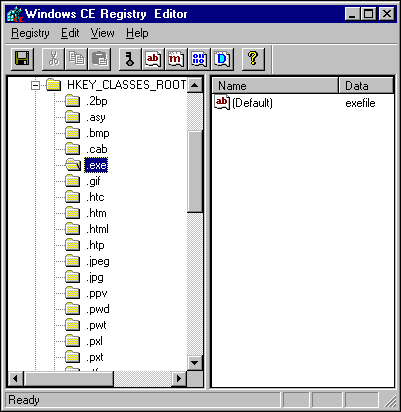
The Windows CE Remote Registry Editor is a tool for editing Windows CE system registries and adding, deleting, and modifying registry keys on Windows CE-based devices. The Windows CE system registry resides in the object store on the remote device.
The Registry Editor window displays the My Computer and My Emulation top-level registry headings, as well as a registry heading for each device to which the registry editor is connected. For example, if the Registry Editor is connected to an H/PC, the Registry Editor will contain a My HPC top-level registry heading.
Double-click the appropriate registry heading to view system registry information, including information about top level registry keys, for the desktop computer, emulation environment, or a device. The Registry Editor supports emulation and can be used on multiple devices simultaneously. The following screen shot shows the Registry Editor window.

The following table shows and describes the top-level registry keys.
Registry Key |
Description |
| HKEY_LOCAL_MACHINE | The root key for configuration information |
| HKEY_CLASSES_ROOT | The root key for associating a file with an application |
| HKEY_CURRENT_USER | The root key for configuration information about the user currently logged on to the system |
The Registry Editor enables you to download and edit registry keys, as well as view them. To download a registry key from a device, double-click the registry heading that corresponds to the remote device, such as My HPC, and then double-click a top-level registry key.
After the remote registry key downloads to your desktop computer, you can edit the key. When you edit the downloaded registry key, the user interface (UI) uses the Remote API (RAPI) to directly edit the registry of the remote device. You can export your Windows CE registry as a text file for easy viewing, as shown in the following procedure.
 To export the registry to a text file
To export the registry to a text fileYou also can use the Registry Editor to add, change, rename, and delete keys and values from the registry.
 To add a key or value to the registry
To add a key or value to the registry–Or–
Select the Key icon or an icon that corresponds to one of the value types. Hold an icon in the down position for a brief moment to see its corresponding value.
To delete or rename a registry key or value, select the key or value from the registry list and choose Delete on the Edit menu to delete it or Rename to rename it. To change a registry value, double-click the value you want to change and enter a new value in the New Value dialog box.